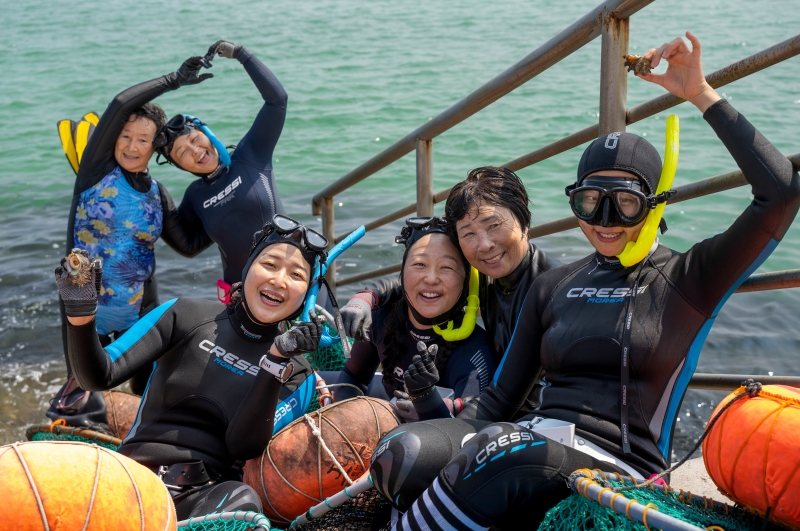The villages of Dongbaek (Camellia) and Sehwa on Jeju Island in June were designated excellent examples of global gastronomy tourism at the inaugural United Nations Regional Forum on Gastronomy Tourism for Asia and the Pacific in Cebu, the Philippines. The town of Namwon-eup, where Dongbaek is located, is a hub of camellia oil and Gujwa-eup (Sehwa) drives regional tourism with haenyeo (female divers), who symbolize the community's strength. Korea.net from Sept. 4-5 visited both villages to learn more about their culinary treasures.
By Margareth Theresia and Aisylu Akhmetzianova
Video = Lee Jun Young
Dongbaek (Camellia) Village, located in Sinheung-2ri (village) of the town of Namwon-eup in Seogwipo, Jeju Island, and with a tradition of over 300 years, is gaining global attention for its community's project to utilize camellia resources.
Launching its venture in 2007, Dongbaek last year was named to the list of Best Tourism Villages by the organization UN Tourism and a gastronomy tourism benchmark this year. Behind its success is its "village community."
So how has Dongbaek gained the global spotlight? The answer lies in Dongbaek's camellias that decorate the village and a traditional mill that makes camellia oil.
With a history dating back to 1706, the village has about 20,000 camellia trees that form a cluster, earning it the designation Jeju Monument No. 27. Villagers harvest the camellia fruit and compress it into oil, stimulating the region's economy and preserving Jeju's cultural value.
The camellia harvest runs from late September to late November. The village's elderly women collect the fruits and send them to the mill, where the fruits are turned into oil. The uses of the oil depend on the duration and manner of seed roasting.
Choi Hye Yeon, secretariat of the Dongbaek Town Preservation and Research Council, said, "Over-roasted camellia oil has a strong scent like sesame oil, so it's good to mix it with bibimbap (rice with vegetables, meat and spicy red pepper paste). Lightly roasted oil is suitable for making pasta or salad dressing."
"Raw oil can be used for aesthetic purposes."
Among the village's interactive programs, an extremely popular one is Dongbaek Bibimbap Menu. Visitors can see the process of making camellia oil and eat bibimbap made with that oil.
The light yet rich flavor of the oil went well with bracken fern directly collected by residents and seasonal vegetables, softly touching the tip of the tongue. The oil elevated the natural sweet taste of the vegetables to produce a savory but non-greasy taste.
On the health benefits of the oil, Choi said, "Camellia oil is dubbed the Eastern olive oil rich in omega-9, making it highly nutritious."

Participants in a four-day haenyeo (female diver) interactive program and course instructors on Sept. 8 pose with the top shells they collected. (Kim Da Eun)
Like Dongbaek, Sehwa was also named an excellent example of gastronomy tourism. Located in the town of Gujwa-eup, Jeju City, the large village boasts a 600-year history and is home to about 2,200 residents.
Sehwa is also famous for Darangswi Oreum, a volcanic cone (oreum) dubbed the "queen of Jeju volcanic cones; output of 60%-70% of the nation's carrots; and the birthplace of a 1932 movement led by haenyeo (female divers) against the Japanese colonial government. Thus this village exudes Jeju's strong spirit.
In 2019, 477 residents joined forces to set up Sehwa Village Cooperative to improve their village. The venture develops tourism packages such as those featuring haenyeo and the sea, volcanic cones and the town, and sumbisori, or the sound that haenyeo make when breathing. Of these, the haenyeo program is particularly popular.
Sehwa PD (chief) Yang Gun-mo attributed the program's popularity to "haenyeo's distinctive way of muljil (diving into the sea and collecting seafood), which doesn't harm nature and is done purely through human breath, and the culture of creating dishes made from seafood they catch."
Participants can dive into the sea with haenyeo to learn to catch, prepare and cook sea urchins, octopuses and top shells into foods like ramyeon (instant noodles) and other noodle types. The plan is to expand the menu to kkochi (cooked food skewers) and food braised in soy sauce.
Shin Kyung-yoon, a 30-something participant in the program, said she found it new and intriguing the first time she experienced it in November last year. She later returned to Sehwa with her three best friends.
"We picked up the top shells collected by haenyeo and placed on the rocks, followed them down to see where the shells were and learned everything one by one," she said excitedly. "We talked a lot with haenyeo as we made lunch and grew closer with them."
Thus Dongbaek and Sehwa are pursuing sustainable development as tourist destinations featuring distinctive regional culture and unique cuisine.
margareth@korea.kr
